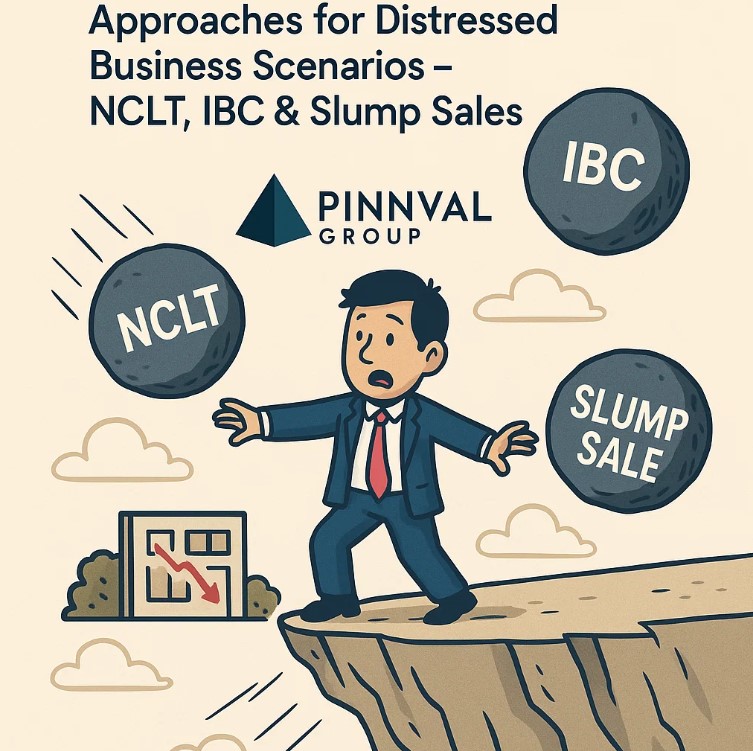
Valuing the Edge: Approaches for Distressed Business Scenarios – NCLT, IBC & Slump Sales
In the world of corporate finance, not all valuation assignments occur in healthy, thriving business environments. Often, valuers are called upon when the stakes are high, cash is tight, and businesses are under legal or financial duress. Distressed scenarios—such as those under NCLT proceedings, insolvency under the IBC, or during a slump sale—demand specialized valuation approaches that go beyond the conventional. Understanding the nuances in such cases is crucial for professionals, stakeholders, and decision-makers.
Can valuation be precise when a business is distressed, disordered, and up against time?
In slump sales and bankruptcies, value isn’t just in assets—it's in the ability to see opportunity when others see risk.
1. Understanding Distressed Valuation
Distressed valuation refers to determining the worth of a business or asset under financial or operational stress. This may include insolvency, bankruptcy, or forced asset sales where market dynamics, legal restrictions, and time constraints differ significantly from typical fair market conditions.
Key Characteristics:
- Limited access to capital
- High uncertainty and risk
- Time-sensitive decision-making
- Legal or regulatory involvement
2. NCLT Proceedings: The IBC Lens
Under the Insolvency and Bankruptcy Code (IBC), the National Company Law Tribunal (NCLT) handles corporate insolvency resolution. Here, valuation plays a pivotal role in aiding the Committee of Creditors (CoC) to make informed decisions on resolution plans.
Key Valuation Requirements:
- Registered Valuers: As mandated by IBBI, at least two registered valuers must assess the fair value and liquidation value.
- Fair Value: The estimated realizable value of the assets in an orderly transaction between willing parties.
- Liquidation Value: The estimated realizable value of assets when the corporate debtor is liquidated.
Challenges:
- Lack of financial clarity and historic records
- Limited buyer interest and marketability discounts
- Legal uncertainties during the resolution process
3. Bankruptcy and Liquidation: Realizing the Floor
In bankruptcy or liquidation, the emphasis shifts from potential growth to asset recovery. Here, the valuation must reflect forced-sale conditions, reduced demand, and often, lower realizable values.
Approaches Commonly Used:
- Asset-Based Approach: Especially relevant when income streams have dried up. Net realizable value (NRV) of tangible and intangible assets is key.
- Market Approach: Challenging but used where comparables exist, adjusted for distress discounts.
- Income Approach: Generally avoided unless partial cash flows are stable or guaranteed.
Key Considerations:
- Fire-sale discounts
- Costs of disposal and recovery
- Creditor seniority and claim structures

4. Slump Sale: Asset Transfer with Business Continuity
A slump sale is the transfer of an undertaking as a going concern for a lump sum, without assigning individual values to assets and liabilities. While not always a distress sale, slump sales are often used during restructuring or exit planning in financially strained situations.
Valuation Approach:
- Business Valuation: Valuers typically apply the DCF method, adjusted for distressed conditions, or comparable transaction multiples if applicable.
- Regulatory Compliance: Valuation must align with Income Tax Act, Companies Act, and SEBI norms if listed.
Points of Caution:
- Ensure the “going concern” assumption is valid
- Adjust for liabilities that transfer with the business
- Consider GST and stamp duty implications
5. Practical Challenges in Distressed Valuation
Distressed valuation is as much an art as it is a science. It requires a blend of technical expertise, judgment, and risk-awareness.
Common Pitfalls:
- Over-reliance on historical data
- Underestimating buyer risk perceptions
- Inaccurate asset identification or classification
Best Practices:
- Robust due diligence under limited timelines
- Multiple scenario modeling (best case, worst case)
- Stakeholder alignment with valuation assumptions
6. Conclusion: Precision in Uncertainty
Valuation in distressed business scenarios is not about perfection—it's about providing reliable, supportable, and defensible estimates in uncertain environments. Whether under NCLT, bankruptcy, or slump sale conditions, a sound valuation framework offers a compass to navigate chaos. In these moments of transition, the right valuation doesn’t just price the business—it helps preserve, unlock, or transfer its residual value to the most efficient hands.
